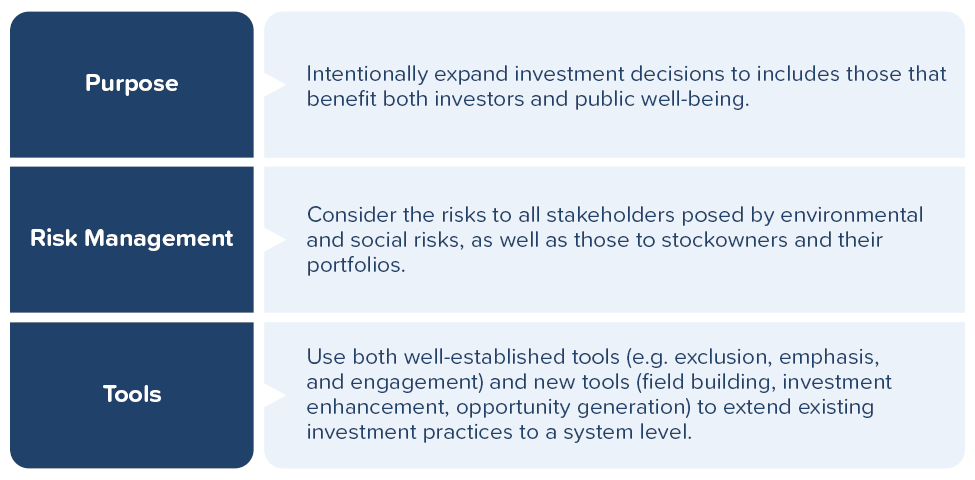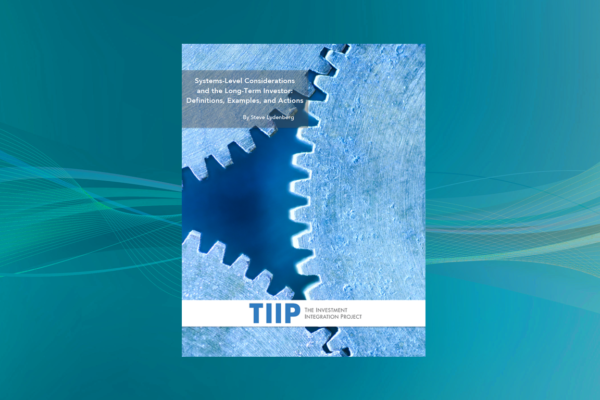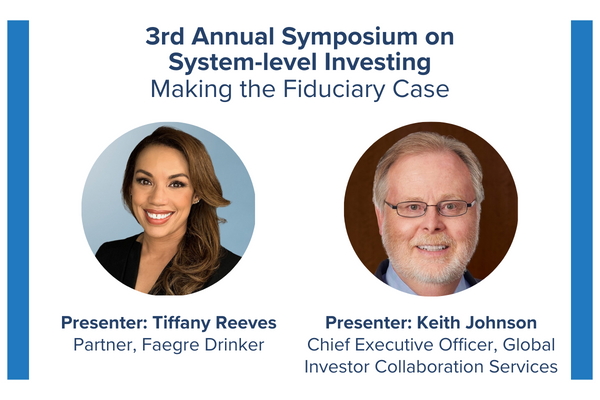Introduction
To support investors in extending or adapting existing policies, programs or practices to the system-level, TIIP developed seven hypothetical scenarios. These scenarios illustrate the nature of these transitions through such things as the re-thinking of purpose, the expansion of their risk management techniques, and the use of tools designed explicitly for system-level influence.

To illustrate these transitions, we chose three different systemic challenges:
- Climate change
- Income inequality
- Availability of sustainability data
Each scenario focuses on an investor from a different silo of the investment world:
- Pensions
- Diversified financials
- Foundations
- Family offices
- Insurance
- Private equity
Each scenario describes the investor and their current status relative to conventional or sustainable investment; the catalytic moment that prompts a decision to change; the challenges in moving forward specific to their institution; their preparation for overcoming those obstacles; the actions they take to do so; and long-term management considerations necessary once that transition to system-level investment has been made.
The purpose of these scenarios is to illustrate seven of the fundamental types of transitions that will arise no matter the type of system challenge or investor. The scenarios assume investors starting from an initial minimal commitment to ESG integration and then portray obstacles that typically stand in the way of a transition to integration of an explicitly systemic approach and steps typically useful in that transition. They are stories about turning points in the journey to fulfilling the full promise of investment: to benefit society as well as the individual. Our hope is that these scenarios help investors today as they address the twists and turns on the road to realizing that potential.
How an Investment Consultant Transitions to the System-level
Case Overview: An Investment Consulting Firm Navigates Challenging Conversations
An investment consulting firm navigates contentious conversations internally and with clients around social and environmental issues by supporting scenario planning.
Key Takeaways
- An investment consulting firm has several contentious conversations internally and with clients about social and environmental issues, in response to increased client demand.
- The firm decides to create a summit to support scenario planning for their clients, including a table-top exercise with its clients to examine the potential investment consequences of a variety of plausible scenarios related to deteriorating social systems.
Case Detail
STU is an investment consulting firm with over 50 institutional clients. Most of the firm’s clientele are either public retirement funds or Taft-Hartley multiemployer trusts. STU is organized with a Client Group responsible for client-facing investment advice and relationship management, and a Research Group tasked with understanding and recommending investment strategies and products for the firm’s clients. At the firm’s monthly update meeting between representatives of the Client Group and Research Group, two of the firm’s investment consultants reported on five client meetings in the prior month.
At four of those meetings, several trustees expressed concerns over their Fund’s exposure to social risks that have become more prominent during the Covid-19 pandemic. The events discussed included large demonstrations across the country focused on racial equality; uneven public support of growing numbers of unemployed workers who cannot keep up with their housing rental or mortgage payments; and a syndicated article in a prominent newspaper that anticipates a sharp increase in personal bankruptcies as growing numbers of furloughed workers lose access to employer-sponsored health insurance.
In all four meetings, the investment consultants note that the Fund investment staff and Fund counsel cautioned trustees to stay within the bounds of their fiduciary duty to seek the highest risk-adjusted returns for the beneficiaries of the Fund. In the case of one Taft-Hartley Fund, the discussion amongst trustees and staff became heated, with accusations made of politicizing the Fund’s activities. The investment consultants indicated that beyond discussing STU’s point of view related to the pandemic on the pharmaceutical industry’s prospects and exposure to biotech in a private equity fund of funds held by each of the Funds, they sought to stay neutral and relatively quiet during such polarizing debates.
A relatively new member of the Research Group suggested that while the issues have political relevance, they also have impact on portfolio returns, which prompted additional discussion of the potential performance of mortgage-backed securities and pharma and insurance stocks held in the Funds. The Research Group member interrupted this conversation after a few minutes to clarify that she had in mind more systemic effects on returns if social unrest and insecurity were to persist for more than the immediate health crisis. The head of the Client Group stated flatly that those were concerns for the ballot box and concluded the discussion with various administrative matters.
Subsequently, the Research Group member developed a proposal for STU to lead a table-top exercise with its clients to examine the potential investment consequences of a variety of plausible scenarios related to deteriorating social systems. The head of the Client Group warmed to the proposal, noting that by approaching the issues initially with a view to exploration and education, Fund decision-makers would be well within their fiduciary responsibilities. Further, the Client Group head suggested bringing together clients for a summit meeting to conduct the table-top exercise, offering further value to clients by connecting them with their peers and enriching the scenario analysis with a variety of viewpoints.
The first such summit is held seven months later and includes presentations by several policy analysts and economists to help facilitate and frame the scenario analysis. Representatives of eight of the Funds’ staff and trustees attend, and the day’s discussion ends with recommendations to focus their public policy advocacy on economic resilience (including new approaches to unemployment insurance processing) and ideas for further investment research with the potential to apply catastrophe bond structures to residential rental payments.
Further Reading
Steve Lydenberg, Robert Dannhauser, and William Burckart, “Graduating from ESG to Systems: Scenarios for Investors,” Money Management Institute and The Investment Integration Project, October 2020.
To learn more
Existing SAIL subscribers can access this post here. For a complimentary access to the CoPractice, request a demo or learn how to become a subscriber, contact us at [email protected].



